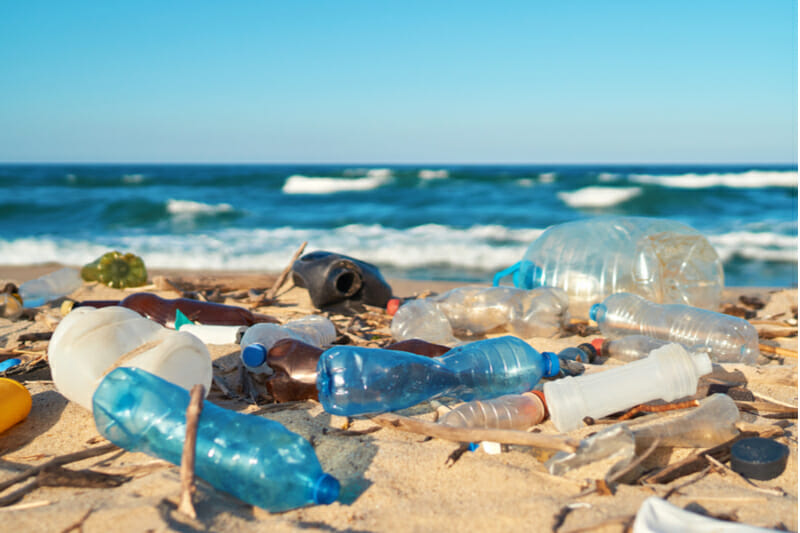Packaging Gateway looks into what oxo-biodegradable plastics are, whether they’re bad for the environment, and the current debates surrounding the material.
Oxo-biodegradable Plastics Association (OPA) chairman Michael Stephen has said that he was disinvited to the upcoming ‘Plastic Free World Conference & Expo’ in Berlin due to his views on oxo-biodegradable plastics.
Stephen told news source PlasticsToday: “There is a campaign against oxo-biodegradable plastics promoted by the bio-based plastics industry, on which they must by now have spent millions of dollars. They are obviously not doing this to protect the environment but to damage their competitors.”
“One of their tactics is to mislead people into thinking that oxo-biodegradable plastic is the same as oxo-degradable plastic when they know it is not. They know that oxo-degradable plastic creates persistent microplastics and that oxo-biodegradable plastic does not.”
Critics of the material say that the plastic does not biodegrade but breaks into microplastics which are then released into the environment and cause significant harm, especially to ocean life.
Defenders of oxo-biodegradable plastics, however, claim that it degrades significantly faster than that of other plastics. UK-based plastics manufacturer Symphony Environmental said: “There are some scientists who are not expert in oxo-biodegradable technology and there are mischievous individuals or companies who are spreading misinformation because they wish to give their own product an advantage in the marketplace that it does not deserve on merit.”
Packaging Gateway looks into what oxo-biodegradable plastics are and the debates surrounding the material.
Oxo-biodegradable vs. biodegradable
Biodegradable means that the material can decompose. It is an end-of-life option that uses microorganisms or bacteria in disposal environments, such as in compost, to decompose plastic and avoid pollution.
According to the World Wide Fund for Nature (WWF), non-biodegradable plastic used for plastic bags will take 20 years to decompose, plastic straws 200 years, plastic rings 400 years, and water bottles 450 years.
Symphony Environmental says that oxo-biodegradable material converts plastic products into biodegradable material through oxidation.
On its website, Symphony Environmental said: “Oxo-biodegradable plastic degrades and biodegrades in the open environment in the same way as nature’s wastes, only quicker. What’s more, it does so without leaving any toxic residues or fragments of plastic behind.”
However, according to Reaven Services founder and packaging expert Abhishek Moon, oxo-biodegradable plastics use metal salts to start the degradation process, resulting in small plastic fragments.
Symphony’s Michael Stephen, however, told Packaging Gateway that this is not true: “The metal salts accelerate the natural process of oxidation but this does not create plastic fragments – it creates low molecular weight oligomers which can be digested by microbes and are not fragments of plastic.”
Moon said: “Further degradation [of oxo-biodegradable plastic] depends on living organisms and bacteria. Products using this plastic typically don’t break down fully in normal landfills. This may be due [to] a lack of oxygen. Also, as another negative, some oxo-biodegradable plastics use cobalt and carry the risk of further environmental pollution.”
In response to this, Stephen told Packaging Gateway: “But oxo-biodegradable technology is not intended to promote biodegradation in landfill, because if plastic is in landfill it has already been responsibly disposed of. Furthermore, biodegradation in anaerobic conditions in landfill would generate methane – a powerful greenhouse gas.”
Moon also said: “[Oxo-biodegradable plastics] are made by incorporation of specific additives into traditional plastics such as Polyethylene (PE), Polypropylene (PP), Polystyrene (PS), Polyethylene Terephthalate (PET) and sometimes also Polyvinylchloride (PVC) at the moment of conversion into final products. The additives are based on chemical catalysts, containing transition metals such as cobalt, manganese, iron, etc., which cause fragmentation as a result of chemical oxidation of the plastics’ polymer chains triggered by UV irradiation or heat exposure.”
Oxo-biodegradable vs. oxo-degradable
Oxo plastics, or oxo-degradable plastics, use additives to accelerate the material’s fragmentation into small pieces. Over time, these fragments become microplastics. There is, however, some confusion over the differences between oxo-degradable and oxo-biodegradable.
Symphony Environmental says that oxo-biodegradable plastic technology facilitates biodegradation of plastics in the air or seawater by bacteria and without causing any toxicity.
In November 2017, The Ellen MacArthur Foundation released a report calling for the ban of oxo-degradable plastic packaging, with signatories including M&S, PepsiCo, Unilever, and WWF. This report was criticised by the OPA for being inaccurate, arguing that many of the signatories were promoting bioplastic technology.
In March 2019, the European Parliament approved a law that would ban single-use plastics by 2021, including oxo-degradable plastics. The Oxo-Biodegradable Plastics Federation (OBPF) criticised that the Directive did not make a clear distinction between oxo-degradable and oxo-biodegradable.
OBPF chairman Gary Ogden told PlasticsToday: “What we really have a problem with is that the Single-Use Plastics Directive says ‘oxo-degradable’ and by default, it means ‘oxo-biodegradable’ but they won’t say it.”
BBIA calls for oxo-degradable ban in the UK
Last month, the Bio-based and Biodegradable Industries Association (BBIA) alongside other associations wrote an open letter to the UK Department of Environment, Food, and Rural Affairs (DEFRA).
In the letter, the association called for a “total ban on the use, sale and distribution in the UK of conventional non-biodegradable plastics containing additives, which are meant to accelerate the fragmentation of plastics into microplastics. Such plastics are variously known as ‘oxo-degradable’, ‘oxo-biodegradable’, ‘oxo-fragmentable’, ‘bio-assimilable’, but the definitions are not exhaustive.”
Signatories of the letter included BBIA, Greenpeace, A Plastic Planet, and five more organisations.
Symphony Environmental responded to this open letter, claiming that the BBIA had ulterior motives. It said: “The BBIA has the word British in its name but it is the UK trade association for the bio-based plastics industry, which comprises predominantly German and Italian companies, and it is important to ask why they have assembled this consortium against oxo-biodegradable plastic.
“This needs to be understood as part of a concerted lobbying and PR campaign over nearly 20 years by the bio-based plastics industry, upon which they must by now have spent millions of Euros. They are obviously not spending this money and making all this effort to protect the environment – they are doing it because they – mistakenly- see oxo-biodegradable plastic as a threat to their market share. Their actions are fundamentally anti-competitive and are designed to stifle a competing technology.
“Worse still – if they succeed they will have deprived policymakers of a technology which could be used to deal with plastic which has escaped into the open environment, from which it cannot be collected for recycling, composting, or anything else.”







